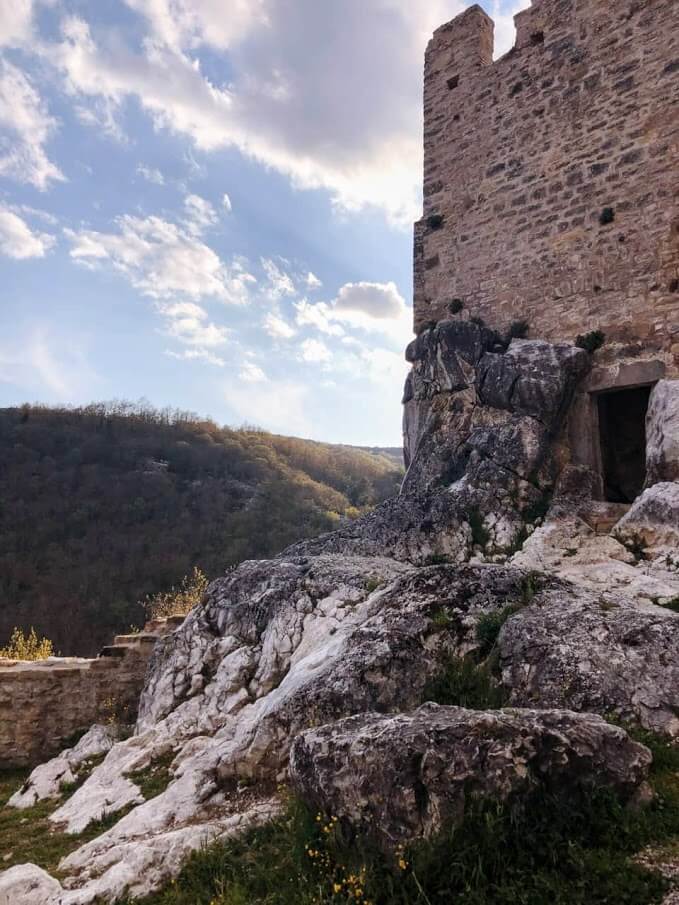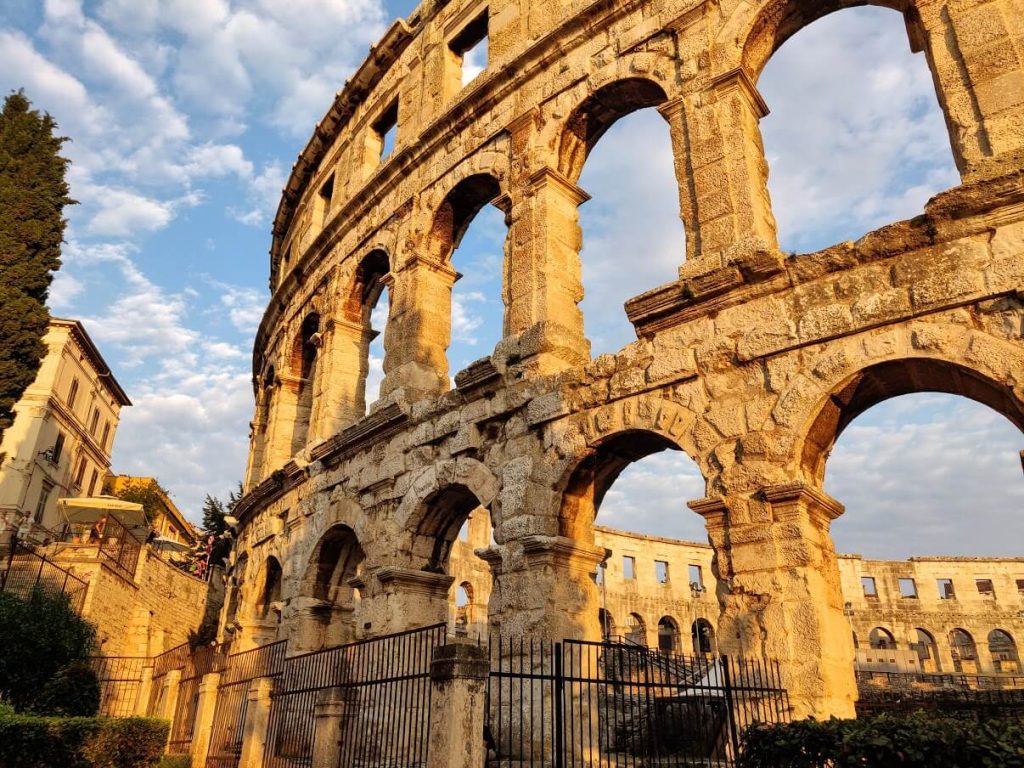The largest Croatian peninsula Istria is filled with charming historic towns, medieval stone houses and fantastic cultural sites. In this article, we’re bringing you some of the most beautiful archaeological sites in Istria you shouldn’t miss while there.
Archaeological sites in Istria you shouldn’t miss
The author of this article about the archaeological sites in Istria is Emina Paćalat, an archaeologist living in Istria.
Since Istria is the region where I was born and spent my childhood, I naturally feel most connected to this part of Croatia. Also, I was a history and art addict since elementary school. Years later, I graduated from archaeology. That is why I decided to write an article about some of the most impressive archaeological sites in Istria.
Istria is the largest Croatian peninsula situated in the northwestern part of the country, very close to Slovenia and Italy. Moreover, it is a heaven for culture and art enthusiasts. So, if you find yourself in this description, I am sure you will immediately fall in love with it.
⤷ Read more: Istria Travel Guide
Dvigrad
Dvigrad is a medieval archaeological site which name means ‘two cities’. In history, it actually consisted of two towns next to each other. One of them was called Parentin, and another Monkaštel.
In medieval times Dvigrad had around one thousand inhabitants. The number itself speaks about its importance. As a result, you can still see many remains of the houses, together with some other objects.
The best known among them is the church of St. Sophia, situated on the main square (on the top of the hill). The church was decorated with frescos dated to the 8th century. Besides its artistic value, this is important since we do not have many examples of the frescos from the Carolingian period in Istria.
Unfortunately, you won’t be able to see the frescos, because they were removed and preserved in the Archaeological Museum of Istria in Pula.
During the 16th and 17th century, Dvigrad was affected by plague and malaria. It was the main reason it got abandoned in the 17th century.
⤷ TIP: Dvigrad is situated between Kanfanar and Rovinj, but not on the main route. Still, it is not difficult to find the site since the local road will lead you directly in front of it.
Monkodonja archaeological site
Monkodonja is a Bronze Age site from 1800 to 1300 BC located at the top of a small hill near Rovinj. It was well organized and divided into three parts. The part on the top is called Akropola, and only the privileged lived there.
The lower parts of Monkodonja also had many houses and other objects. Those were the parts for the lower classes. Most importantly, you will be able to see many of the remains even now, many centuries later.
⤷ TIP: If you love nature, I highly recommend visiting the nature park Zlatni rt (Golden Cape), as well. Zlatni rt is a forest cape that left me speechless when I first saw it. Also, it is a perfect location for having a picnic and spending a relaxing afternoon next to the sea.
Castles Possert and Belaj
Most people have heard of popular sites such as Pula, Rovinj or Poreč, located near the sea in Istria. On the other hand, Possert and Belaj Castles are situated in the countryside of the peninsula. They belong to the municipality of Cerovlje.
Possert was built in the 14th century. But, it was by no means a typical medieval castle. Most of the similar fortifications in Istria from the same period had defensive roles. On the contrary, life in Possert was better adjusted and arranged for everyday life. If you travel to Possert, I suggest visiting a nearby Belaj, as well.
Family Bardo built the Belaj Castle in the second half of the 17th century. It contains two vineries and a vineyard with a breathtaking view typical for central Istria. It is even possible to arrange a private tour throughout the complex. The fun fact and a coincidence is that Belaj is also its current owner’s last name!
⤷ Read more: Day trip to Brijuni Islands
Petrapilosa
Petrapilosa is a feudal fortress in northern Istria, near the border with Slovenia. It is situated on the top of the cliff, just above the small river called Bračana. Besides the defensive role, the fortress also had a residential one.
Unfortunately, the castle got affected by fire in the 17th century. After that event, the owners never restored it. Even though this archaeological site in Istria is well known to local people, its popularity grown in the last few years. It got revitalized due to the project called KulTERRA. That also means the entrance is not free, but buying the ticket is for sure worth it.
⤷ TIP: If you decide to visit Petrapilosa, I highly recommend going to Paladini, a nearby picturesque village known for truffles by the family Karlić. I think it would be a bad idea not to try this Istrian speciality if you have a chance. Similarly, if you would like to experience truffle hunting, you can also do that there! Can there be a better way to feel the authentic atmosphere of Istria?
Vižula archaeological park
The best-known archaeological park in Istria is situated in the south of the peninsula, near Medulin, and is called Vižula. It was populated from Prehistory to the Medieval Ages. Still, it is most famous for its Roman villa and ancient buildings.
Some parts of the Roman villa are now under the water. Of course, it was very luxurious for the time it was built, and some of the remains proving that are still visible.
For example, it had beautiful mosaics, water supply, and floor heating. Vižula became an archaeological park in the summer of 2019. Since then, you can enjoy walking through the park while admiring nature, the sea, and the interactive content.
⤷ TIP: The park is well-adjusted for families with children. It consists of a playground and it’s not too close to the main road. That is to say, Vižula is the perfect destination for archaeology enthusiasts in Istria as well as for families with kids.
Nesactium
One of the most famous archaeological sites in Istria is Nesactium (or Nezakcij in Croatian), situated near the Pula airport. It was the capital of the Iron Age tribe called Histri that gave the name to the peninsula – (H)Istria.
Many legends have been told about the Histri tribe. Moreover, some of them even become theatre plays, taking place directly on the site. Isn’t that a great way to relive prehistoric times?
Nesactium was a hillfort ruled by King Epulon. Besides the legends and the remained architecture, it is well-known for its art. Histri had a sophisticated sense of aesthetic. They made beautiful pots, jewellery, and other objects known for their specific motives. Likewise, Histri were great sculptors as well. Their fascinating stone sculptures show some Greek and Etruscan influence.
Unfortunately, Nesactium was attacked and destroyed in the year 177 BC. After that, it became a part of the Roman Republic. Still, a lot of the hillfort remains kept living through all these centuries. And if you are interested in prehistoric times, it is an ideal destination for you.
⤷ Read more: 20 Archaeological sites you have to visit in Europe
The Euphrasian Basilica
The Euphrasian Basilica (Eufrazijeva bazilika in Croatian) was named after Saint Euphrasius. It is one of the symbols of Poreč, a small town on the west coast of Istria.
It also found its place on the UNESCO World Heritage list. That fact itself speaks about its importance. Sacral objects that preceded today’s Cathedral dates to the 4th century. The first stage of the complex is called Domus ecclesiae. The famous fish mosaic is from that period, as well.
After many upgrades and changes, a new basilica was built in the 6th century. It is best known for its breathtaking mosaics depicting Christ, Apostles, and Virgin Mary, among many other motives. The most similar ones are from Rome and Ravenna.
The Cathedral in Poreč is one of the best-preserved early Byzantine basilicas in Europe. So, if you are a fan of Byzantine art, this beautiful basilica is one of the Istrian archaeological sites that should be on your bucket list.
⤷ Read more: Medieval frescoes in Istria
Archaeological sites in Pula city centre
Pula is the largest city in Istria with a rich history, most famous for the monuments from the ancient period. To clarify, it is full of breathtaking ancient Roman architecture and art.
It is best known for its Amphitheatre. The term arena is how most locals refer to it. It is situated near the sea with the closest parking lot just a minute away by walk. Even though Pula is a town where I went to high school and passed by this magnificent building every day, it still fascinates me every time I see it.
The Amphitheatre in Pula is one of the best-preserved amphitheatres that remained from the Roman period. The construction started during the reign of the emperor August in 27 BC and ended in 68 AD. It was used for gladiator and other games and could accommodate 23 000 people. Today, you can enjoy listening to concerts, watching movies during Pula Film Festival, or just visiting it while imagining yourself in the past times.
Besides the Arena, this city is famous for much more monuments and archaeological sites from the same period. You can read here about some of the best-preserved ones.
The first one is the Arch of the Sergii. It is a triumphal arch situated in the strict centre of the town, on your way from the Giardini (city square with lots of coffee shops) to the Forum. The interesting fact is that a woman named Salvia Postuma from the Sergii family paid for it.
When you pass through the Arch, you will continue your walk on the Via Sergii, called by locals Prvomajska Ulica (Prvomajska street). At the end of your few minutes long walk, you will find yourself at the front of a beautiful Roman Forum. It was, and still is, the main town square.
Temple of Augustus is situated there, as well. Besides being dedicated to Augustus, it was probably even built in his time! It is possible to enter the temple for a symbolic price, but you can also admire it from the outside. For example, while sitting in one of the coffee shops at Forum.
⤷ TIP: I would highly recommend Cvajner since you will get a beautiful view, an artistic atmosphere, and last but not least, a delicious latte macchiato!
⤷ Read more: What to do & see in Pula in a day
Istria is a heaven for anyone who admires art and history. It’s a small region, so it is not impossible to visit both the coast and the countryside in just a few days. I would also recommend travelling by car since most of the picturesque sites are not near the cities. Even though Istria is a very touristic region, you can always find less crowded parts, where you can relax and enjoy watching its beautiful architecture and unique nature. And, of course, some of the fantastic archaeological sites in Istria.
*Cover photo by Nick Cane from Unsplash












